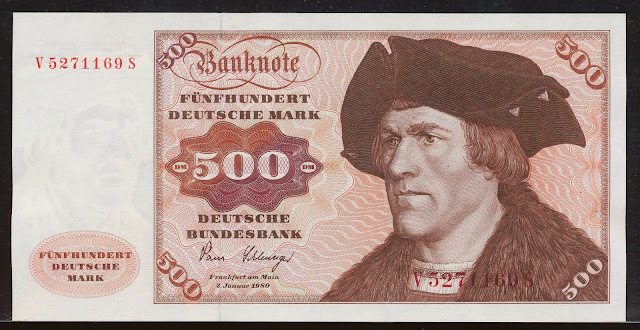German banknotes 500 DM Deutsche Mark banknote 1980, issued by the Deutsche Bundesbank - German Federal Bank
500 Deutsche Mark old German pre-euro bank note.
German banknotes, German mark banknotes, Deutsche Mark, German paper money, German bank notes, Germany banknotes, Germany paper money, Germany bank notes, German currency, German East African banknotes, German Rentenmark.Obverse: Portrait of a Man Without Beard - Renaissance painting by Hans Maler zu Schwaz (Kunsthistorisches Museum Wien).
Reverse: The Eltz Castle (German: Burg Eltz) in Rhineland-Palatinate symbolizes the German chivalry. This spectacular Medieval castle - possibly the most magical of all German castles.
Germany banknotes - Germany paper money
Deutsche Bundesbank - German Federal Bank
1960-1980 issue
The third series of German mark banknotes was introduced in 1960 by the Bundesbank, depicting neutral symbols, paintings by the German painter Albrecht Dürer, and buildings. There were 5 Deutsche Mark, 10 Deutsche Mark, 20 Deutsche Mark, 50 Deutsche Mark, 100 Deutsche Mark, 500 Deutsche Mark and 1000 Mark denominations.
5 Deutsche Mark 10 Deutsche Mark 20 Deutsche Mark 50 Deutsche Mark
100 Deutsche Mark 500 Deutsche Mark 1000 Deutsche Mark
100 Deutsche Mark 500 Deutsche Mark 1000 Deutsche Mark
Hans Maler zu Schwaz
Hans Maler zu Schwaz (1480–1526/1529) was a German painter born in Ulm and active as portraitist in the village of Schwaz, near Innsbruck. Maler may have trained with the German artist Bartholomäus Zeitblom, who was chief master of the School of Ulm between 1484 and 1517. He painted numerous portraits of members of the Habsburg court at Innsbruck as well as of wealthy merchants such as the Fuggers.
Maler's two most important patrons were Ferdinand I of Austria, who at the time was Archduke (Later Emperor) and the celebrated Fuggers. Ferdinand is known to have commissioned at least three portraits of himself and four of his wife, Anna of Bohemia and Hungary. Maler also painted portraits in 1517 of Sebastian Andorfer, a successful metal maker and merchant from Schwaz. His portrait style rarely varied from his bust-format, where the subject's hands were not shown and without eye contact to the viewer.
He received commissions early on in his career from Ferdinand's grandfather, Maximilian I and was also commissioned in 1508 for frescoes depicting the Habsburg family tree in Ambras Castle.
Eltz Castle
Eltz Castle (German: Burg Eltz) is a medieval castle nestling in the hills above the Moselle River between Koblenz and Trier, Germany. It is still owned by a branch of the same family that lived there in the 12th century, 33 generations ago. The Rübenach and Rodendorf families' homes in the castle are open to the public, while the Kempenich branch of the family uses the other third of the castle. The Palace of Bürresheim (Schloss Bürresheim), the Castle of Eltz and the Castle of Lissingen are the only castles on the left bank of the Rhine in Rhineland-Palatinate which have never been destroyed.
The castle is surrounded on three sides by the Elzbach River, a tributary on the north side of the Moselle. It is situated on a 70 m rock spur, on an important Roman trade route between rich farmlands and their markets.
The castle is a so-called Ganerbenburg, or castle belonging to a community of joint heirs. This is a castle divided into several parts, which belong to different families or different branches of a family; this usually occurs when multiple owners of one or more territories jointly build a castle to house themselves. Only a very rich medieval European lord could afford to build a castle on his land; many of them only owned one village, or even only a part of a village. This was an insufficient base to afford a castle. Such lords lived in a knight's house, which was a simple house, scarcely bigger than those of his tenants. In some parts of the Holy Roman Empire of the German Nation, inheritance law required that the estate be divided between all successors. These successors, each of whose individual inheritance was too small to build a castle of his own, could build a castle together, where each owned one separate part for housing and all of them together shared the defensive fortification. In the case of Eltz, the family comprised three branches and the existing castle was enhanced with three separate complexes of buildings.
The main part of the castle consists of the family portions. At up to eight stories, these eight towers reach heights of between 30 and 40 meters. They are fortified with strong exterior walls; to the yard they present a partial framework. About 100 members of the owners' families lived in the over 100 rooms of the castle.
Platteltz, a Romanesque keep, is the oldest part of the castle. In 1472 the Rübenach house, built in the Late Gothic style, was completed. Remarkable are the Rübenach Lower Hall, a living room, and the Rübenach bedchamber with its opulently decorated walls.
Between 1490 and 1540, the Rodendorf house was constructed, also in Late Gothic style. It contains the vaulted "banner-room".
The Kempenich houses were finished about 1530. Every room of this part of the castle could be heated; in contrast, other castles might only have one or two heated rooms.

